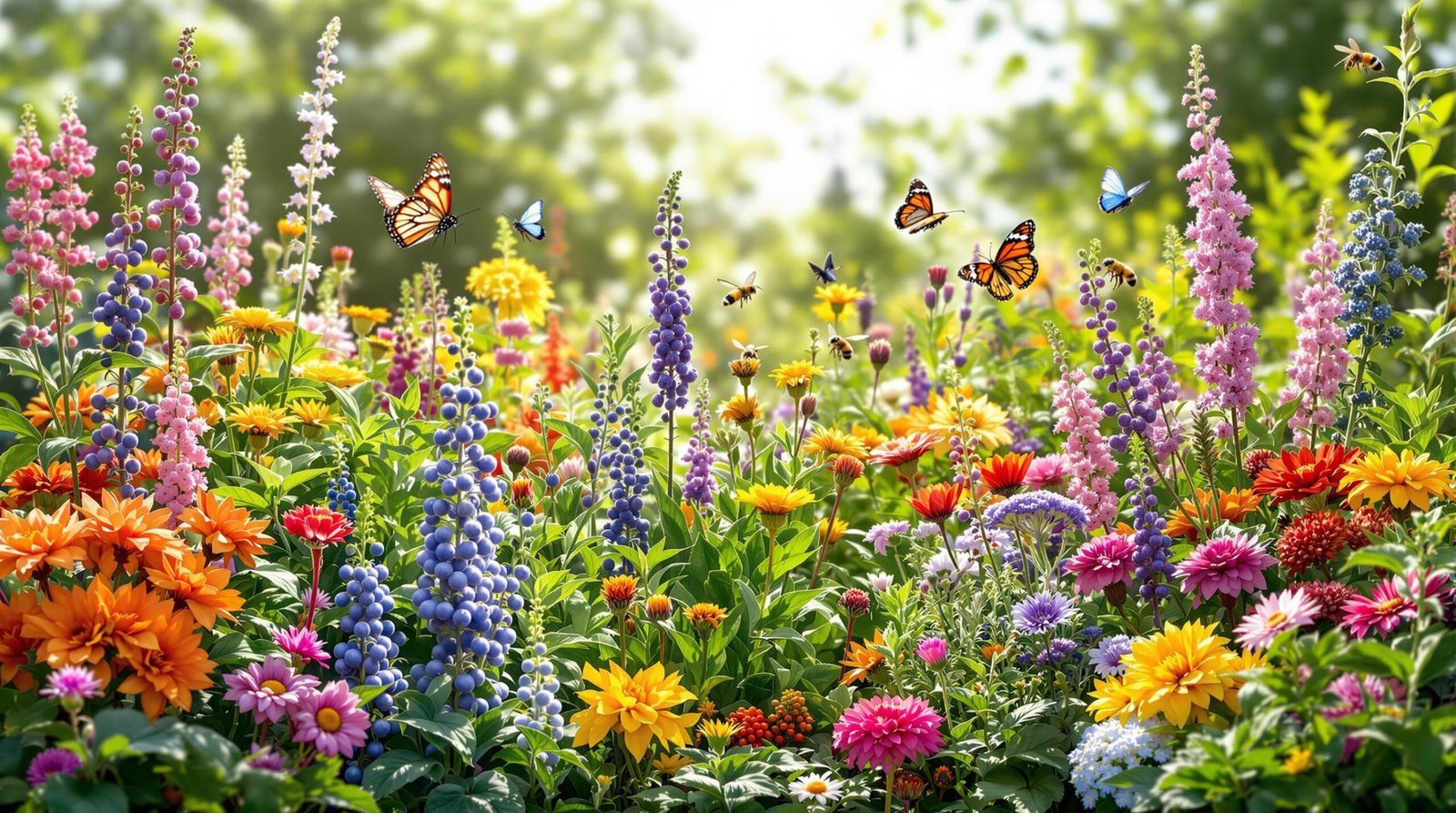
One of the best reasons to grow native plants is to help local pollinators! Insects, birds, and mammals depend on them for nectar, pollen, fruit, and shelter. The most beneficial plants for pollinators are those native to your area. Here are 15 excellent native species for gardens in the northeastern U.S.
Echinacea purpurea with pink petals and a spiky orange center, bee on top
The popularity of native plants is rising, and I couldn’t be happier! While exotic plants may look stunning, they often don’t support local pollinators. Many bees can’t even reach their flowers, leaving them without the pollen and nectar they need to survive.
That said, not all non-native plants are harmful—only the invasive, fast-spreading ones should be avoided. Non-invasive, nectar-rich plants can actually benefit generalist pollinators. Unlike specialist species that rely on specific flowers, generalists thrive on a variety of blooms.
And remember, starting small is perfectly fine! Every new plant you add to your garden provides another food source for pollinators. Even small actions can have a big, lasting impact on the ecosystem.
For the best results, begin with one or two of these 15 native pollinator plants from the Northeast. They’re incredibly valuable to pollinating insects, nesting birds, and butterflies and moths raising their young.
American Witchhazel
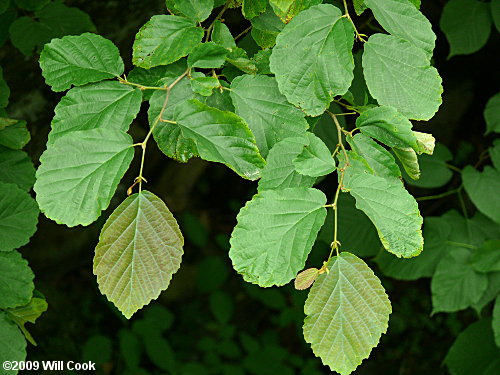
Yellow, ribbon-like flowers in clusters bloom on bare branches, contrasting with the branching structure. After flowering, small fruits form, feeding birds, squirrels, and turkeys in the fall.
Common Name: American Witchhazel
Botanical Name: Hamamelis virginiana
Sun Requirements: Full sun to partial shade
Height: 15-30’
Hardiness Zones: 3-9
One of the earliest bloomers in late winter, American witchhazels brighten eastern forests with spider-like flowers. Each bloom has spindly petals that dangle like spider legs! Moths, bees, pollinating flies, and other insects love them.
Once the flowers fade, small fruits develop, which birds and squirrels enjoy. The remaining seeds become a favorite food for foraging turkeys.
This shrub isn’t just great for wildlife—it’s also a striking ornamental plant. Its dual appeal makes it a fantastic choice for gardens across the U.S., not just the Northeast.
Boneset

Eupatorium perfoliatum with dense white flower clusters and narrow green leaves.
It spreads by seeds and roots, forming pollinator-friendly colonies with white late-summer flowers.
Common Name: Boneset
Botanical Name: Eupatorium perfoliatum
Sun Requirements: Full sun to partial shade
Height: 4-6’
Hardiness Zones: 3-9
Boneset thrives in wetlands! It handles soggy soil well, making it ideal for swamps, marshes, and bogs. If other plants struggle in a wet spot in your yard, try replacing them with boneset.
Once established, it spreads through roots and seeds, forming large colonies that pollinators love. Its white flowers bloom in late summer and fall, drawing beneficial insects to your garden.
Dense Blazing Star
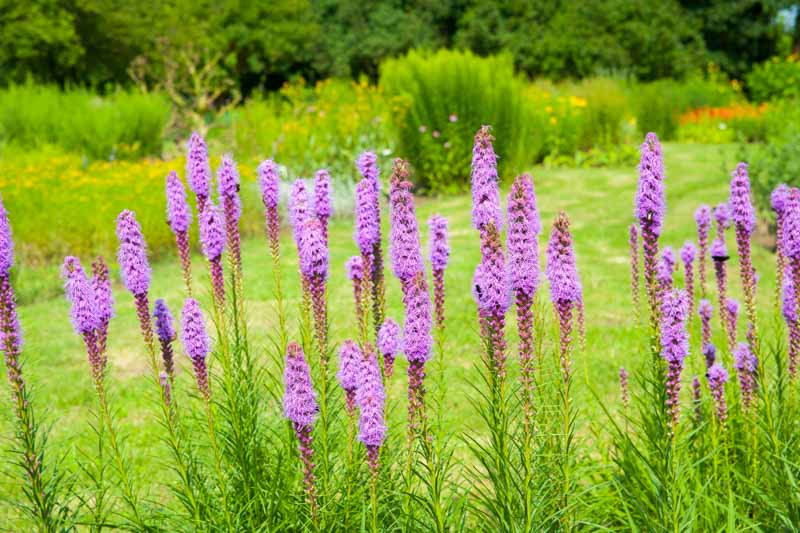
Tall, slender stems with narrow, grass-like leaves, topped with dense spikes of small, feathery purple flowers.
They attract hummingbirds, bees, and butterflies in sunny borders or wild meadows.
Common Name: Dense Blazing Star
Botanical Name: Liatris spicata
Sun Requirements: Full sun
Height: 2-4’
Hardiness Zones: 3-8
Blazing stars often appear in wildflower seed mixes. They grow quickly, return yearly, and produce tall spikes of small, fringe-like purple blooms (some varieties are pink or white).
Perfect for open, sunny areas like meadows and borders, dense blazing stars draw hummingbirds, bees, and butterflies in summer and fall.
Joe Pye Weed
Pretty monarch butterflies attracted to dome-shaped clusters of tiny, pinkish-purple flowers atop tall stems.
This Northeast native thrives in moist areas and attracts many pollinators.
Common Name: Joe Pye Weed
Botanical Name: Eutrochium fistulosum
Sun Requirements: Full sun to partial shade
Height: 4-8’
Hardiness Zones: 4-8
Joe Pye weed shines in tough spots. This tall wildflower has large, dense flower heads packed with tiny blooms. Plant it behind shorter perennials—it’ll grow tall, creating a beautiful backdrop.
Like boneset, it loves wet soil and thrives in meadows, forests, and damp fields. Bees, butterflies, and other pollinators adore its flowers, while birds feast on its seeds.
Lance Self Heal

Prunella lanceolata with purple tubular flowers above short leafy stems.
It supports bees and soil critters with spring nectar and spreading ground cover.
Common Name: Lance Self Heal
Botanical Name: Prunella vulgaris ssp. lanceolata
Sun Requirements: Full sun to partial shade
Height: 10″
Hardiness Zones: 4-9
Don’t confuse this with its weedy European cousin! Lance self heal is a pollinator-friendly Northeast native, and I’d argue it’s prettier too—its large purple flower heads are far showier.
This low-growing perennial is perfect for rock gardens, borders, and pollinator habitats. Bees flock to its spring blooms for nectar and pollen, while its spreading stems shelter soil-dwelling insects.
Milkweed
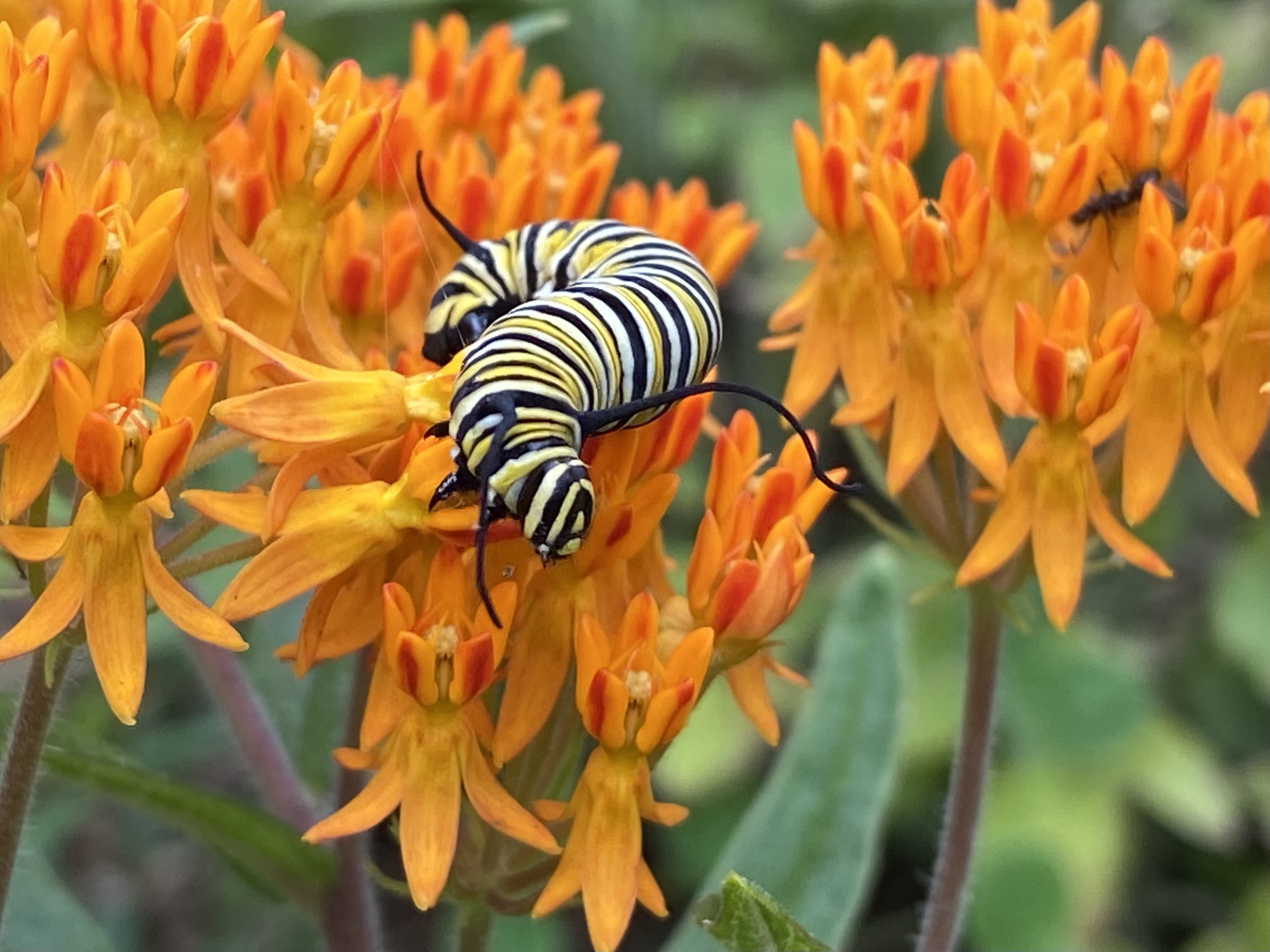
A compact plant with slender stems, narrow green leaves, and vibrant orange flowers in flat-topped clusters.
Milkweeds support butterflies with nectar-rich blooms and foliage for hungry caterpillars.
Common Name: Milkweed
Botanical Name: Asclepias spp.
Sun Requirements: Full sun to partial shade
Height: 1-5’
Hardiness Zones: 3-9
Dozens of milkweed species grow across the U.S., some unique to specific regions. Check local nurseries for varieties native to your area, or choose these Northeast favorites:
- Butterfly Flower (Asclepias tuberosa)
- Common Milkweed (Asclepias syriaca)
- Swamp Milkweed (Asclepias incarnata)
If you want to help butterflies, plant milkweed! Adults sip nectar from the flowers, while caterpillars munch the leaves.
New Jersey Tea

Ceanothus americanus with tiny white flower clusters and oval green leaves.
It feeds bees, butterflies, and birds with fragrant white flowers and useful seeds.
Common Name: New Jersey Tea
Botanical Name: Ceanothus americanus
Sun Requirements: Full sun to partial shade
Height: 2-3’
Hardiness Zones: 4-8
Think of this as the East Coast’s answer to California lilac! Both are in the Ceanothus genus, but New Jersey tea thrives in the Northeast. Its deep roots stabilize loose soil, making it ideal for slopes or erosion-prone areas.
When in bloom, this shrub dazzles with fragrant white flowers that attract butterflies, bees, moths, and birds.
Purple Coneflower
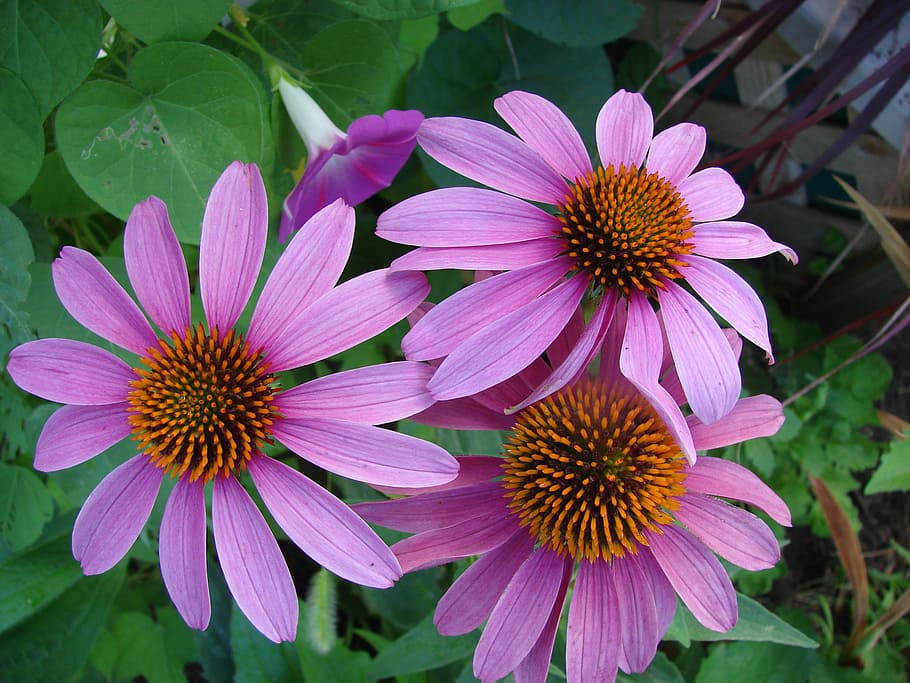
Echinacea purpurea with drooping purple petals and a round orange cone center.
They support pollinators with broad blooms and feed birds with fall seed heads.
Common Name: Purple Coneflower
Botanical Name: Echinacea purpurea
Sun Requirements: Full sun to partial shade
Height: 3-4’
Hardiness Zones: 3-8
An iconic North American native, purple coneflower is a global garden favorite. Its spiky orange centers and purple petals act as landing pads for bees, hoverflies, and butterflies.
Come fall, the seed heads become a buffet for birds. Pro tip: Leave them standing through winter for winged visitors!
Red Columbine
Aquilegia canadensis with red backward spurs and yellow inner petals.
It likes shady spots and moist, well-drained soil with annual compost near roots.
Common Name: Red Columbine
Botanical Name: Aquilegia canadensis
Sun Requirements: Full sun to partial shade
Height: 1-3’
Hardiness Zones: 3-8
Red columbine lights up forest floors with its red-and-yellow, spur-shaped flowers. Hummingbirds and butterflies can’t resist its nectar!
A self-sowing perennial, it thrives in shade but tolerates sun if the soil stays moist. Boost growth by adding compost around its roots yearly.
Smooth Beardtongue

Penstemon digitalis with white bell-shaped flowers on tall green stalks.
Its blooms smell sweet and attract butterflies, bees, and hummingbirds.
Common Name: Smooth Beardtongue
Botanical Name: Penstemon digitalis
Sun Requirements: Full sun to partial shade
Height: 2-4’
Hardiness Zones: 3-8
While many beardtongues are exotic, stick with this Northeast native for pollinators. It grows wild in sunny meadows and open forests.
Foxglove-like white flowers rise above lance-shaped leaves, their sweet scent drawing butterflies, bees, and hummingbirds.
Smooth Blue Aster
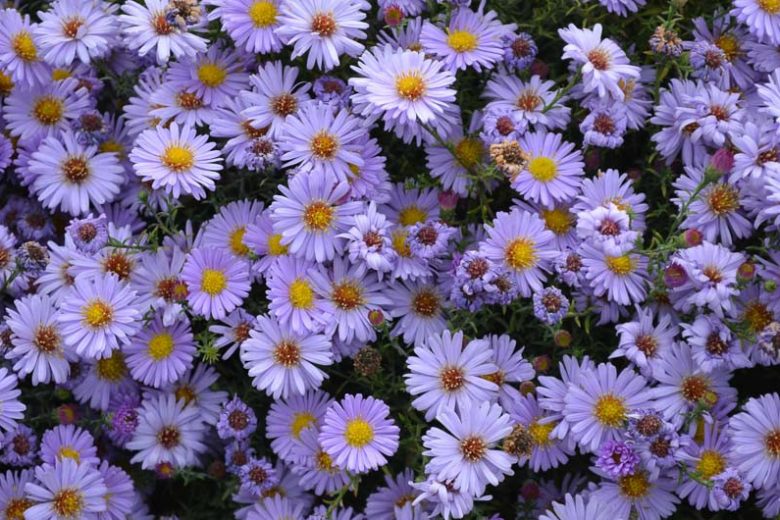
Symphyotrichum laeve with star-like lavender flowers and yellow centers.
Smooth blue asters bloom alongside goldenrods, creating a stunning late-summer contrast.
Common Name: Smooth Blue Aster
Botanical Name: Symphyotrichum laeve
Sun Requirements: Full sun to partial shade
Height: 2-4’
Hardiness Zones: 4-8
American asters are late-season lifesavers for pollinators. While most flowers fade in late summer, asters burst open with lavender blooms and golden centers—just as goldenrods flower nearby.
A must-have for fall wildlife support!
Stiff Goldenrod

Solidago rigida with thick upright stems and clusters of small golden flowers.
The gorgeous golden spikes are magnets for pollinators.
Common Name: Stiff Goldenrod
Botanical Name: Solidago rigida
Sun Requirements: Full sun
Height: 3-5’
Hardiness Zones: 3-9
Stiff goldenrod’s bright yellow spikes feed specialist bees, bumblebees, and butterflies. But beware—it spreads vigorously via seeds and roots.
Let it roam wild in open spaces, or contain it in pots.
Swamp Verbena
Verbena hastata with white flower spikes rising above thin vertical stems.
Attracts wasps and beetles (great for veggie gardens!) but may self-seed freely.
Common Name: Swamp Verbena
Botanical Name: Verbena hastata
Sun Requirements: Full sun to partial shade
Height: 2-5’
Hardiness Zones: 3-8
This architectural wildflower thrives near water features like ponds. Its blooms lure pollinators, while seeds feed birds like cardinals and sparrows.
Bonus: It also attracts pest-eating wasps and beetles. Ideal for vegetable gardens—just prune unwanted seedlings.
Wild Bergamot
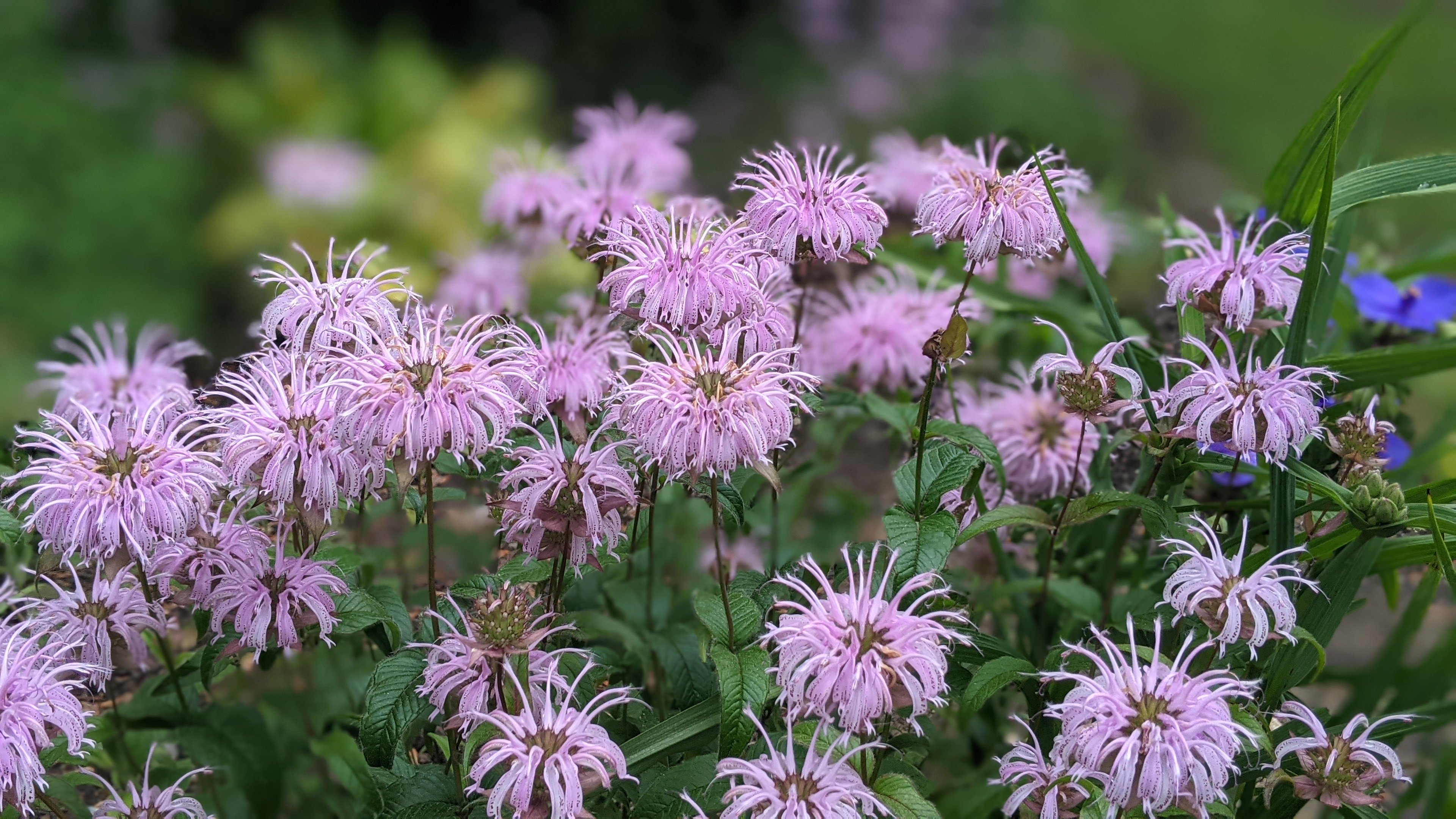
Wild bergamot boasts lance-shaped green leaves and clusters of tubular, lavender flowers.
It spreads via rhizomes and seeds, offering nectar and herbal tea leaves.
Common Name: Wild Bergamot
Botanical Name: Monarda fistulosa
Sun Requirements: Full sun to partial shade
Height: 2-5’
Hardiness Zones: 3-8
A win-win plant! Its leaves make refreshing tea, while lavender-pink flowers nourish hummingbirds, bees, and butterflies.
Like other mints, it spreads enthusiastically. Plant near vegetable beds to boost pollination of crops like squash and cucumbers.
Yarrow

Achillea millefolium with flat white flower heads and soft feathery leaves.
Thrives in most gardens with blooms that support bees (and come in many colors).
Common Name: Yarrow
Botanical Name: Achillea millefolium
Sun Requirements: Full sun
Height: 1-3’
Hardiness Zones: 3-9
Tough, adaptable, and dependable—yarrow grows almost anywhere. While cultivars offer red, pink, or yellow blooms, the native white-flowered type is best for pollinators.
Its clustered blossoms are bee rest stops, and they make long-lasting cut flowers for bouquets, fresh or dried.
FAQs and Conclusion
FAQs
- What kind of soil is best for container gardening?
- For most outdoor plants, use a loose, airy, and well-draining potting mix. Cacti and succulents require a mix with coarse sand or pumice, while vegetables and perennials prefer moisture-retentive soil. A high-quality mix like FoxFarm’s Happy Frog® is suitable for most plants and can be amended for specific needs.
- How do I know if my plant needs repotting?
- Plants typically need repotting if roots are growing through the drainage holes or surfacing. If your plant is growing slowly or seems to be outgrowing its pot, it’s time to repot. Spring or fall are the best times to repot for fresh soil and extra space.
- How often should I water container plants?
- Container plants dry out faster than ground-planted ones, so they generally need watering once a week. However, watering frequency can vary based on the plant type, the size of the pot, and weather conditions. For example, cacti and succulents require less frequent watering, while annuals may need more.
- Can I grow fruit trees in containers?
- Yes! Many fruit trees, including apples, peaches, and plums, can thrive in large containers. Ensure the container is at least 20 gallons in size and has adequate drainage. These trees also need a lot of sunlight, so place them in a spot where they can receive 6-8 hours of direct sunlight per day.
- What’s the best way to fertilize container plants?
- Fertilize regularly with a balanced fertilizer based on your plant’s needs. Flowering and fruiting plants need fertilizers rich in phosphorus and potassium, while leafy greens prefer nitrogen-rich fertilizers. Organic fertilizers are gentler and avoid salt buildup in the soil.
- How do I protect my plants from extreme weather conditions?
- During heatwaves, move plants to cooler spots or use shade cloth to protect them from the sun. For frost protection, cover your plants with row covers at night, and uncover them during the day. Tender plants, such as peppers, may need to be brought indoors during the winter months.
Final Thought
Each of these natives brings unique benefits to your garden and local ecosystem. Whether you plant one or all 15, you’re creating a lifeline for pollinators—one bloom at a time!
Let me know if you’d like any refinements. Otherwise, happy gardening! 🌱🐝

